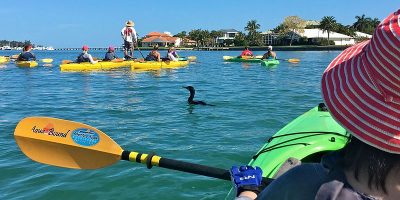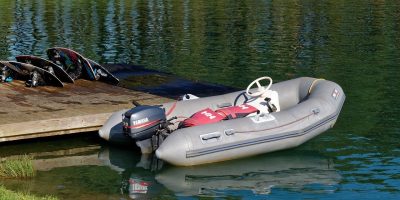Do you squint the whole time while reeling in a catch? Is the sun glare making it hard for you to enjoy your angling trip? If so, it sounds like you’re in need of the best budget polarized sunglasses for fishing. Unlike typical sunglasses, polarized types offer better sun protection, especially in high-glare situations near bodies of water.
Polarized fishing sunglasses aren’t just for vanity. It plays a big role in protecting your eyes from intense sunlight. Most of all, it lets you see your catch better.
For this post, I reviewed 8 of my trusted polarized sunglasses. I’ve tried and used them in my countless fishing trips across the country. See which one matches your style and budget:
| POLARIZED SUNGLASSES | BRAND | EXPERT RATING | CHECK PRICE |
|---|---|---|---|
 | Our Top Pick! KastKing Skidaway Polarized Sunglasses | Check Price | |
 | INFI Fishing Polarized Sunglasses | Check Price | |
 | TOREGE TR26 Polarized Sunglasses | Check Price | |
 | HUK Polarized Sports Sunglasses | Check Price | |
 | Fishoholic Polarized Fishing Sunglasses | Check Price | |
| KastKing Iditarod Polarized Sunglasses | Check Price | ||
 | Costa Del Mar Fantail Polarized Sunglasses | Check Price | |
| Oakley Valve Polarized Sunglasses | Check Price |
Polarized vs. non-polarized sunglasses
There’s always been an unending pursuit to provide optimal eye protection across industries. From NASA astronauts to casual anglers, you can find eyewear that aims to reduce eye damage. One of which is polarized sunglasses.
However, the biggest question is this: what’s the difference between polarized and non-polarized sunglasses?
First, let’s understand how polarized sunglasses work. Technically, polarized glasses are just like any other eye protection. However, it has an additional chemical film. This thin chemical film serves as a reflective surface that prevents sunlight from getting into your eyes.
Moreover, the molecules of polarized sunglasses are arranged in a vertical manner. This allows the coating to block piercing sunlight. Also, this design allows just the right amount of light to get into the wearer’s vision.
Meanwhile, non-polarized sunglasses don’t have this feature. Some are simply tinted and it doesn’t offer much eye protection, especially in the middle of the sea with the sun up.
To ensure that your sunglasses are polarized, you should for a bright reflection when the surface is placed under direct sunlight. Also, if the light intensity changes when you tilt your head sideways at 60 degrees, it means that the sunglasses are polarized.
8 Best Budget Polarized Sunglasses For Fishing
OUR #1 CHOICE
OUR TOP PICK: KastKing Skidaway Polarized Sunglasses
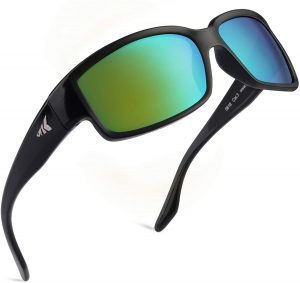
Product Name: KastKing Skidaway Polarized Sunglasses
Product Description: If you’re looking for the best budget polarized sunglasses, I highly recommend the KastKing Skidaway. These sunglasses have a Grilamid frame, which is made of a shape-retaining and light polymer. It can tolerate daily wear and tear. Moreover, these fishing sunglasses are fitted with 1 mm polarized lenses made with Japanese and German materials. The lenses also have a scratch-resistant coating and have passed double decentering tests to ensure that it doesn’t have optical distortion. In addition, the lenses have UV-blocking layers for optimal eye protection. This multi-layer construction guarantees eye comfort and durability even on regular use. Aside from that, these KastKing Polarized Fishing Sunglasses have ergonomic nose pads and a durable pin hinge. You can stay in action on the fishing boat without worrying about your eye protection.
Offer price: $$$
Availability: InStock
-
Polarizing effect
-
Material quality
-
Construction
-
Value for Money
Overall
Summary
The package also includes a rigid protective case as well as a microfiber cleaning pouch. For this price range, this is already a steal.
I also like that these sunglasses are available in a variety of tints. You can get this in brown, blue, copper, smoke, and more. You can pick the lens color that matches your taste.
For this price range, I can say that KastKing delivers premium quality that costs more than other brands. Their eyeglasses are also stylish, which is a big plus.
As for the downside, there’s a minor gap at the bottom, which may allow more light to come in if you have a gaunt face.
Pros
Made with durable Grilamid frame
Equipped with anti-scratch coating
Blocks harmful UV rays
Bundled with a rigid case and pouch
Available in various tints
Cons
There seems to be a gap at the bottom, which can be an issue for those with small faces.
It’s not as dark as some users would like.
RUNNERS-UP
INFI Fishing Polarized Sunglasses
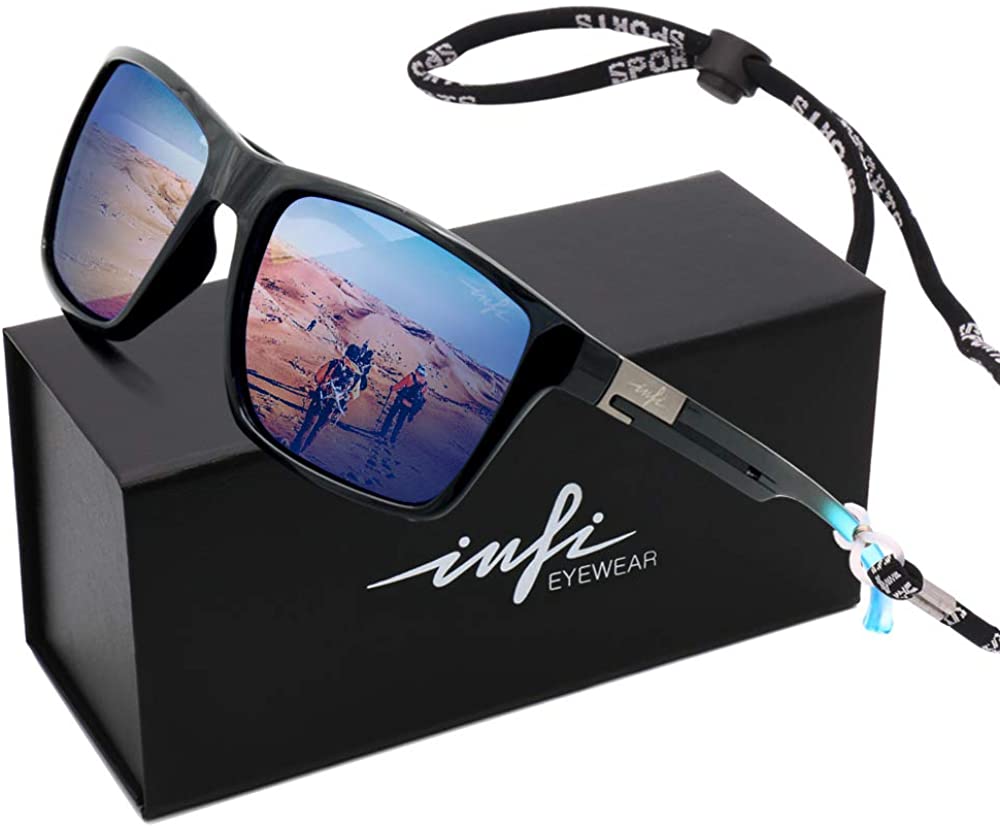
Are you looking for fishing sunglasses that are light as a feather? If so, you won’t be disappointed by the INFI Fishing Polarized Sunglasses. This has the same TAC (triacetate cellulose) lens as the KastKing Skidaway, complete with a mirror coating.
Moreover, these sunglasses are made to be weather-resistant and can endure changing temperatures. You can use this for fishing, running, climbing, and other outdoor activities.
Overall, these polarized sunglasses offer UV400 protection with a 99.5% polarizing effect. It’s also lightweight and will remain comfy to wear for long hours of fishing.
These polarized sunglasses have a 129 mm arm, 18 mm bridge, 43 mm lens height, and 57 mm lens width. It suits most face sizes and it also comes with straps to prevent the glasses from falling off.
You’ll also get a branded gift box, a pouch, and a microfiber cloth. Although it doesn’t come with a rigid case, it’s still presentable enough to be given as a gift.
Based on my experience, these polarized sunglasses work well on cutting glare from the water. I also tried wearing this on the golf course and visibility is off the charts.
However, since the frame is plastic, you have to be extra careful in handling it. Like any plastic material, the frame could break if dropped, sit on, or subjected to force.
TOREGE TR26 Polarized Sunglasses

The TOREGE Polarized Sunglasses boasts its proprietary DSX-SR technology that makes the lens saltwater-resistant. It’s also oleophobic and hydrophobic to ensure optimal vision even on the most action-packed fishing trip.
Moreover, this has a 100% polarization effect, which helps reduce glare, eye strain, and squinting while reeling in your catch. Whether you’re fishing on flat water or inshore, these sunglasses are a must-have.
Aside from that, these polarized fishing sunglasses are equipped with a TR90 frame. It has a no-slip nose pad and a temple design that increases grip. This will prevent the sunglasses from falling off while you move around.
To suit bigger heads, the TOREGE polarized sunglasses have an adjustable spring hinge. It adds flexibility while preventing the arms from snapping.
Another thing that sets the TOREGE brand apart from its competitors is its lifetime warranty. If you received a broken pair, you can contact TOREGE for a free replacement or refund.
Aside from its polarized coating and saltwater-resistant coating, these sunglasses are also fitted with an anti-shock and anti-scratch layer. Overall, there are 13 elements in these lenses to protect your eyes from outdoor hazards.
The package also includes an adjustable strap to prevent your sunglasses from falling into the water. You’ll also get a rigid case, a cleaning cloth, and a soft pouch. Overall, these sunglasses are a good deal for their price.
HUK Polarized Sports Sunglasses
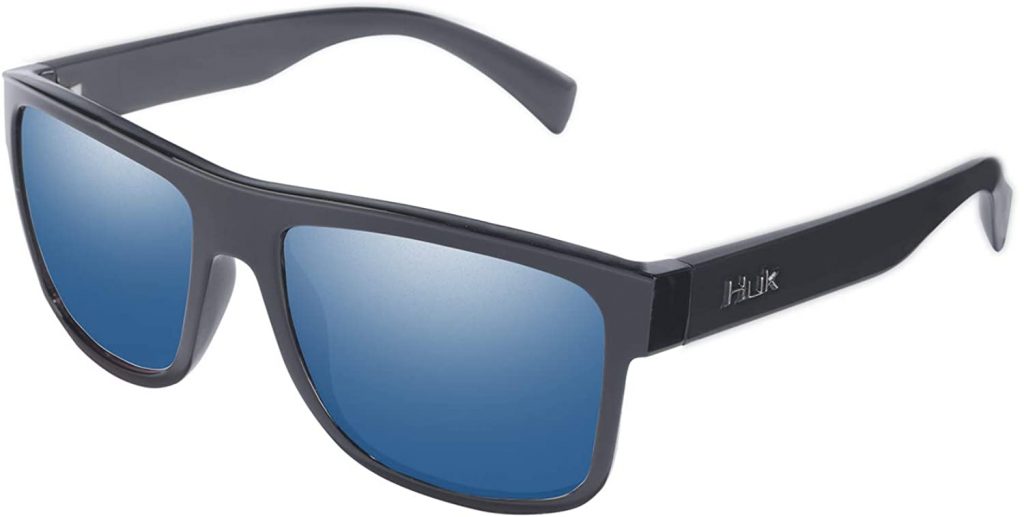
The HUK Polarized Sports Sunglasses are fitted with polycarbonate lenses with a plastic frame. It bears an authentic polarized coating as well as a UV coating to repel harmful rays. Overall, it offers 100% UV protection, so you can up your angling game even on a sunny day.
Moreover, these sunglasses use a TR90 injected frame. It’s lightweight, durable, and can put up with daily use. It also retains its shape without pinching your nose or temple.
The HUK Polarized Sunglasses also sport an 8-base wrap design for better light blocking. It also has non-slip rubber ends that add grip, so your sunglasses won’t fall off into the water.
Aside from that, these fishing sunglasses are available in various tint colors. You can also select between medium and large sizes to suit your face.
Many users compare this to the quality of more expensive Costa Del Mar sunglasses. It doesn’t cause headaches and they are very comfy to wear for extended periods.
The only downside here is that sunlight tends to penetrate at the side of the sunglasses. This is a bit surprising since it has a wrap design. But for this price range, I really don’t have major complaints.
Fishoholic Polarized Fishing Sunglasses
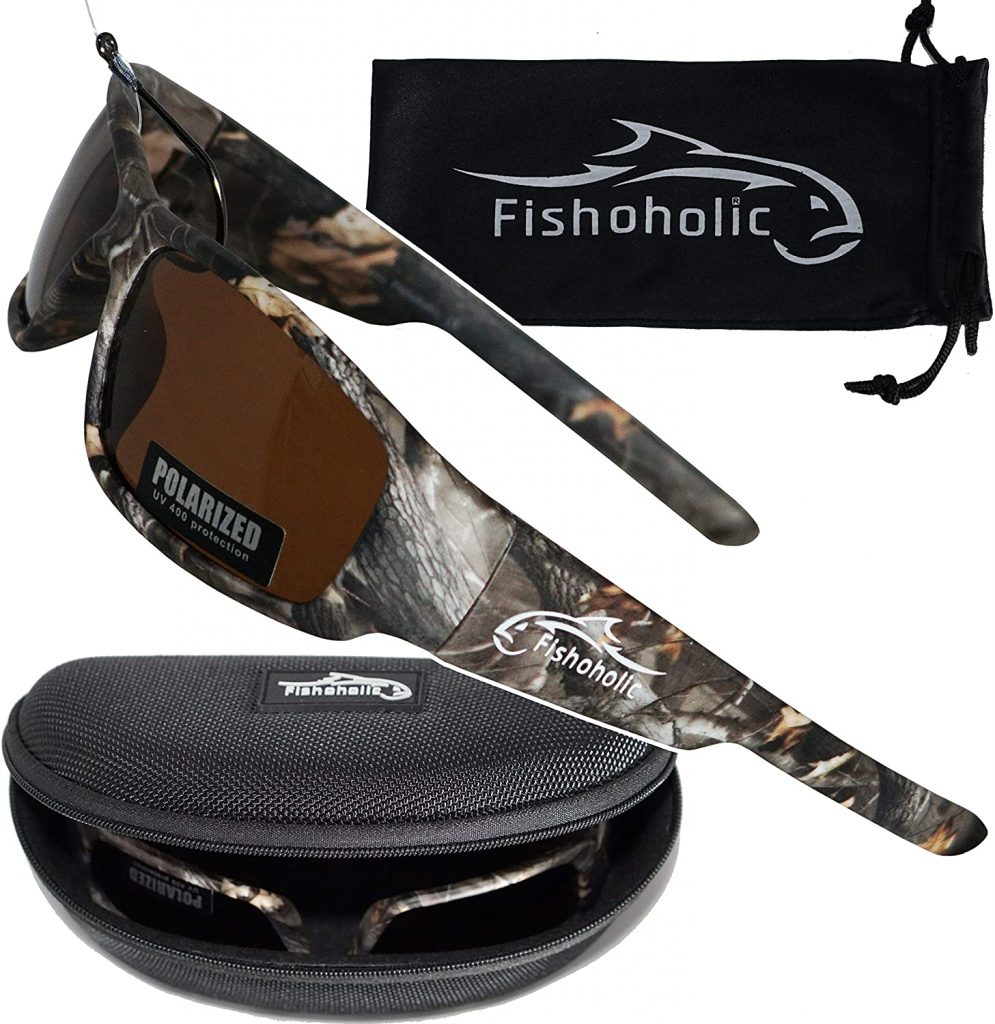
If you’re looking for polarized sunglasses made specifically for anglers, you won’t be disappointed by the Fishoholic Polarized Fishing Sunglasses. This is engineered to provide eye protection even during the most intense glare on the water.
Moreover, these sunglasses have UV400 protection to block harmful sun rays. I also like the wide and wrapped sides that will prevent sunlight from piercing through.
These Fishoholic sunglasses have a tight fit, so if you have a large head, it might feel a little too snug. I think this design is intentional since the sunglasses will not float in case you drop them into the water.
Take note that these sunglasses have a plastic frame, so you have to be careful not to damage them. But since this is a budget pair, you really can’t have any major complaints.
I also noticed that the lens tends to have streaking issues, but it’s not really a big deal. As long as you keep it clean and store it well, this pair will last a great deal of time.
Lastly, this Fishoholic sunglasses pair isn’t the best choice for saltwater. The saltwater will damage the coating, so it’s more suitable for freshwater and flatwater fishing.
KastKing Iditarod Polarized Sunglasses
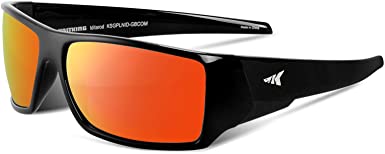
Another KastKing polarized sunglasses I recommend is the Iditarod model. It also uses the same TAC polarized lenses with a Grilamid frame. Overall, it’s made to endure the toughest fishing conditions at a very competitive price.
Moreover, the lenses of the KastKing Iditarod have passed the double decentering test. This is to ensure that the sunglasses don’t have optical distortion that could impede your vision and cause headaches.
Aside from that, the Grilamid frame of these sunglasses offers a durable yet lightweight feel. It’s also UV-resistant and flexible. This makes the sunglasses suitable for small to large face sizes without the risk of breaking.
Another thing I really like about these sunglasses is their saltwater-resistant coating. Since saltwater can ruin polarized coating, this added layer ensures that you can get your game on, whether you’re river fishing or surf fishing.
Overall, you can choose from different lens colors and tints to suit your style and preferred brightness. The only complaint most wearers have is that the arms are a bit slippery. Nevertheless, a strap will always come in handy.
Costa Del Mar Fantail Polarized Sunglasses
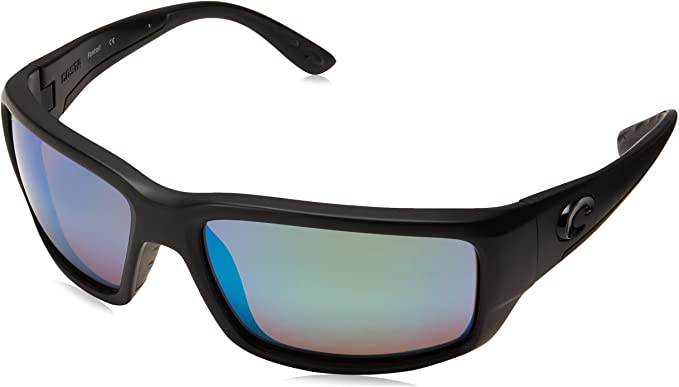
If you can spend a little more without going too fancy, I recommend the Costa Del Mar Fantail Polarized Sunglasses. This is trusted by thousands of anglers all over the world due to its excellent optical quality, great build, and wide range of tint options.
The Costa Del Mar lenses are made of 580 polycarbonate, which resists scratches, impact, and daily wear and tear. It’s paired with a bio-based nylon frame that’s also tough and made to last. Whether you’re fishing, driving, going to the golf course, and more, these sunglasses are great to wear.
Moreover, these sunglasses have a 100% polarizing effect. This reduces eye strain and cuts glare, so you can see the water clearly.
Aside from that, Costa Del Mar builds their sunglasses by hand and backs them with a lifetime warranty. While this one is slightly more expensive, you’ll get more value in the long run.
From fishing carp or hooking a sea behemoth, Costa Del Mar sunglasses are made to deliver topnotch optical performance.
Oakley Valve Polarized Sunglasses
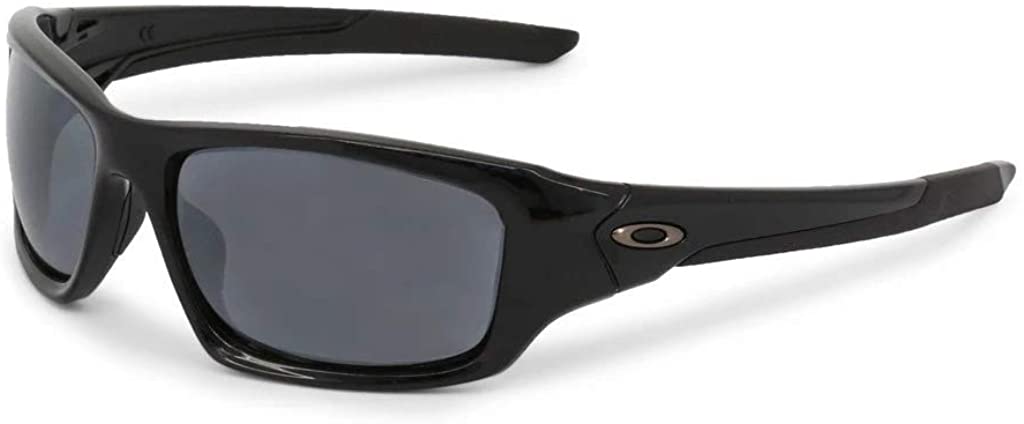
Another option I recommend for those who can spend a little more is the Oakley Valve Polarized Sunglasses. This is made with plastic lenses and a plastic frame, which delivers excellent optical clarity while fishing.
Moreover, this is polarized and has 100% UV protection. The best part is that the lenses are prescription-ready for those who have poor eyesight. You simply take it to your optometrist and prescription lenses can be installed in less than 30 minutes.
Aside from that, these sunglasses are stress-resistant and can endure daily use. You can also choose from several tints to suit your preferred style and brightness.
All Oakley sunglasses have the brand’s proprietary Plutonite material, which adds impact resistance and sunlight protection.
Take note that the Oakley Valve Polarized Sunglasses have narrower ear stems. Nevertheless, it has a wrapped design that makes it snug. It also prevents light from piercing through the sides.
Also, it tends to get the eye area sweaty since it’s not very ventilated. But other than that, these fishing sunglasses are right on the money.
How to choose polarized sunglasses
There are many fishing sunglasses in the market and choosing one can be a tricky task. Also, many pairs are quite expensive, so we will help you find one that’s right on the budget but not short of quality.
Here are some of the points you should keep in mind:
😎Frame shape
The first thing you have to think about is the shape of the sunglasses you’re going to buy. It should match the shape of your face, so you stay stylish while fishing.
Here are a quick rundown of face shapes and what lens shape suits each one:
- Round face. This face shape suits square, rectangle, and wrap lenses to tone add angle on the face.
- Square face. As the opposite of a round face, those with square faces should opt for lens shapes with gentler curves. The likes of round, aviators, and butterfly designs are good options.
- Rectangular face. This face shape suits wayfarers, rectangular, shield, wrap, and square frames. Aside from the size, those with rectangular or oblong faces should avoid very small frames.
- Diamond face. This face shape will look well on rimless and oval frames. Frames with gentle curves are a good option, but the wearer must ensure that the width isn’t wider than the cheekbones.
- Heart face. Those with heart-shaped faces will look well on aviators, rimless frames, and butterfly designs. This helps shift the attention at the bottom of the face and not the forehead.
😎Sunglasses size
Once you picked the frame shape that suits you, it’s time to check the size. While polarized sunglasses come in a universal fit, you have to make sure it suits your face well.
In general, you’d want your fishing sunglasses to fit snugly on your ears and nose without the pinching feeling. This way, it won’t fall off the water in case you have to look down while reeling your catch.
For the right fit, here are a few recommendations:
- Your eyelashes shouldn’t touch the frame unless it’s unusually long.
- Your polarized sunglasses shouldn’t cause pain on contact points.
- The sunglasses shouldn’t fall off when you look down.
- Measure the distance between your temples. A temple-to-temple measurement of 115 mm will usually fit a 49 mm frame.
- You should also check the bridge, which is the distance of the lenses from each other. This is very crucial, especially if you have smaller than usual eyes.
😎Sunglasses material
Another important consideration when shopping for polarized fishing sunglasses is their material. Basically, you have to check two parts: the frame and the lens. Below, I discuss a quick rundown of the commonly used materials to see which one is best.
😎Lens material
The lens material will impact the sunglasses’ clarity, cost, and weight. In general, more durable materials are expensive. Here are the most common options in the market nowadays:
- Acrylic. This lens material is the cheapest and lightest to wear. This is suitable for those on a budget and who are only fishing occasionally. Overall, it’s durable and clear, but there can be some distortion.
- Polycarbonate. This is a tad better than the acrylic in terms of durability and optical clarity. It’s also lightweight to wear, but it’s still a type of plastic. With that, polycarbonate lenses are prone to scratches if you don’t handle them well.
- Polyurethane. This material is more durable than polycarbonate and acrylic. It also offers better optical clarity without being too expensive. It’s also lightweight, but still prone to scratches.
- Glass. If you have the budget, glass lenses are the best bet. It has superior scratch resistance and optical clarity. However, it’s heavier than the other three materials listed here. Also, it was more expensive.
😎Frame material
Aside from the lens material, you also have to check the frame that will hold it. The following are the most common lens materials used in polarized sunglasses nowadays:
- Nylon. This is lightweight, flexible, and budget-friendly. Many nylon frames are also impact resistant and can be adjustable if fitted with a wire core.
- Acetate. This is a plastic frame offered in a variety of colors. However, it’s not as forgiving as nylon and it can easily break when subjected to intense force. Nevertheless, it’s an affordable option.
- Polymer. Castor-based polymer frames are rarely used in polarized sunglasses, but you can still find some in the market. It’s a petroleum-based material that offers a lightweight profile.
- Metal. If you have the money and want to future-proof your polarized fishing sunglasses, I highly recommend that you invest in a metal frame. The likes of titanium and aluminum offer durability on a light package. You can also get stainless steel as a cheaper alternative.
😎Lens tint
The lens tint of polarized sunglasses is typically intended for aesthetic purposes. Nevertheless, it can also add a glare-reducing effect when paired with the polarized coating.
If you’re unsure as to what color to get, the following are the most common options that you can consider:
- Brown. This color is a top favorite since it suits daily use and everyday conditions. Brown tinted polarized sunglasses have better optical clarity in low-light situations.
- Yellow. This tint helps filter blue light, so it also doubles as eyewear when using electronic devices. For fishing, this also works, but not in extremely sunny conditions.
- Blue. A blue tint works well in reducing glare, especially when paired with a polarized coating. It’s also stylish and a favorite among anglers.
- Pink. A pink tint helps reduce eye strain and adds visual depth when worn. It can also be used for fishing, but it’s not as effective as a blue tint in reducing glare.
- Green. A green tint is a widely chosen option as it suits general use. It works in reducing glare, adding contrast to the surroundings, and brightening shadows.
You can find other lens tints in the market aside from these common options. Overall, it’s a matter of personal preference, but make sure that you’re getting an authentic polarized pair.
😎Lens coating
Polarized fishing glasses often come with different types of coating. Aside from the polarized coating, you can also find pairs with the following layers:
- Hydrophobic coating. This added layer wicks away moisture, which is very useful when aiming for game fishes. You no longer have to worry about water splashing into your face.
- Anti-scratch coating. This is often added to lenses made of polycarbonate, acrylic, or polyurethane. It’s intended to compensate for the scratch-prone nature of the plastic material.
- Flash coating. This coating adds a reflective property to the sunglass lenses. It deflects light as it hits the surface, though it’s not really necessary once your lenses already have a polarized coating.
😎Visible light transmission (VLT)
VLT or Visible Light Transmission is the amount of light that gets into your eyes. Each pair of polarized sunglasses come with this rating, which affects the condition to which it’s suitable for use.
Moreover, VLT is measured by percentage – the lower the percentage, the lesser light that could pass through the lens.
Here are the usual VLT ratings you’ll find on polarized fishing sunglasses:
- 0% to 19% – This allows the least amount of light to enter, which is perfect for sunny days.
- 20% to 40% – This is suitable for all-purpose use since it can reduce a substantial amount of glare.
- 40+% – Sunglasses with this VLT rating are only suitable for low-light conditions and cloudy days.
- 80% to 90% – Sunglasses with this VLT rating offer very little protection against sunlight. If you’re looking for the best budget polarized sunglasses for fishing, you should steer clear of this rating.
😎Price range
Lastly, you should consider the price range of the sunglasses you’re going to purchase. The good news is that there are many budget-friendly options that offer excellent eye protection without costing a fortune.
Nevertheless, you should always check the materials, coating, and authenticity of the polarized sunglasses you’re going to buy.
In the end, it’s about finding the right balance between value and features. If you’re opting for a more expensive pair, make sure that it’s covered by a decent warranty.
Overall, I recommend buying from established brands to be sure of the quality. Also, there are brands like KastKing and Fishoholic that make polarized sunglasses specifically designed for anglers.
Frequently Asked Questions
Q: Is there a difference in polarized sunglasses for fishing?
A: Unlike typical sunglasses, polarized types have an additional layer that eliminates sun glare. This allows anglers to look directly into the water without having to squint due to the sunlight. It will help anglers see fishes and other objects underwater better. Compared to non-polarized fishing sunglasses, polarized types offer better eye protection and comfort.
Q: What are the disadvantages of using polarized sunglasses?
A: While polarized sunglasses are beneficial for anglers, it comes with a few downsides. First, it has poor visibility in low-light conditions. Also, it will be a bit difficult to look at LCD screens when wearing these sunglasses. Overall, these downsides are minor and something most anglers can live with.
Q: Can you see your phone with polarized sunglasses?
A: It can be difficult to see your phone screen while wearing polarized sunglasses. Since this accessory is meant to block light, your phone screen will appear dark. Still, this means that the glasses are doing their job. If you need to check your phone in the middle of fishing, you can always push the glasses up your head.
Q: Why do polarized sunglasses make my vision blurry?
A: If the polarized sunglasses are making your vision blurry, it means that the polarization coating isn’t applied evenly. This defect will affect your eyesight and even cause dizziness and headaches. We suggest replacing your polarized sunglasses if this occurs, much so if it’s a dirt-cheap model.
Q: How long does it take to get used to wearing polarized sunglasses?
A: It may feel weird wearing polarized sunglasses the first time. But after two to three days, your vision will adjust and the glasses will be more comfortable to wear. However, if you still feel uncomfortable wearing polarized glasses after a week, you may need to get a better one. There’s a chance that the polarized coating of the glasses isn’t applied properly.
Q: Are polarized sunglasses worth it?
A: Polarized sunglasses offer excellent eye protection and comfort. It reflects sunlight, so you don’t have to squint outdoors. If you want this convenience, then these sunglasses are worth the money. Just make sure that you get the right fit, tint, and materials.
Final words
The best budget polarized sunglasses for fishing will let you observe the water and spot fish better. Whether you’re fishing on a river, lake, sea, or ocean, this eyewear offers both convenience and protection.
What do you think of the sunglasses we reviewed? Share your thoughts below!

